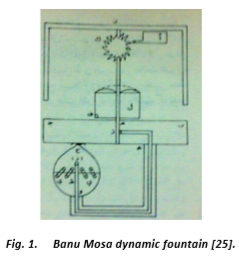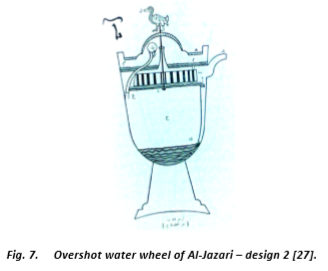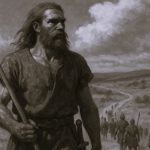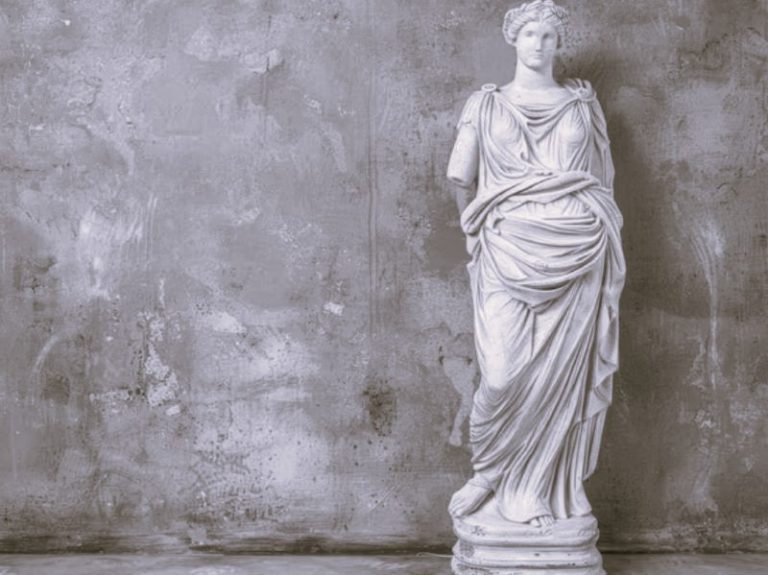


By Dr. Galal Ali Hassaan
Emeritus Professor, Faculty of Engineering
Cairo University
Abstract
The fascinating mechanical inventions aiming at the welfare of the human kind started from ancient Egyptians and continued development through different eras. In the medieval centuries, the Islamic civilization paid wonderful attention to mechanical engineering. Banu Mosa invented 100 ingenious devices including automatic fountains and automatic feedback level control systems. Al-Jazari invented 50 mechanical devices including automatic fountains, clocks, positive displacement pumps and robotics. Taqi Al-Din invented a 6-cylinder positive displacement pump. Those great inventers used clean-energy prime movers in the form of windmills, overshot water wheels and undershot water wheels (turbines). This paper focuses only on windmills, water wheels and automatic fountains.
Introduction
Mechanical machinery in the medieval centuries used clean sources of energy to generate motion and mechanical power. Different types of prime movers started to appear from the 9th century AC in Iraq and then spread to the east with various applications. The genius Arabic mechanical engineers invented windmills, overshot water wheels (turbines) and undershot water wheels and used them in different engineering machinery used for the welfare of the mankind. The role of Arabic/Muslim engineers in this field is clarified by a large number of researchers, scientists and mechanical engineers around the whole world.
Hill (1974) translated an annotated Al-Jazari manuscript on ingenious mechanical devices. As a mechanical engineers he reproduced some of the manuscript drawings and provided modern explanations for their operation. He also handled the Islamic technology up to Al-Jazari including the works of Banu Musa, Al-Khuwarizmi and Ridwan [1]. Hill (1977) a manuscript dated 1266 AC belonging to Ibn Muadh Al-Jayyani (died 1079 AC). He pointed out that Al-Jayyani treatise consists of 31 models in which models numbers 1-5 are very large toys similar to automatic clocks but without precise timing. While models numbers 6-20 and 27-30 are water clocks recording the hours by a moving automata. Models numbers 25 and 26 are raising water machines. Finally, models numbers 21-24 are war machines and 31 is a universal sundial [2]. Al- Hassan (1977) presented the manuscript of Al-Jazari after redrawing some of Al-Jazari machines with English letters concentrating on AlJazari machines for raising water. He provided an English-Arabic Glossary for the terms used in Al-Jazari manuscript [3]. Coomamswamy (1994) pointed out that the Museum of Fine Arts of Boston possesses six leaves of the Arabic manuscript on Automata. He inferred that Al-Jazari was first and foremost a craftsman and secondarily an author. His writing was intelligible and his diagrams were clear explaining his practical experience [4]. Hill (1998) claimed that until modern times there was no other document from any cultural area that provides a comparable wealth of instructions for the design, manufacture and assembly of machines like that of Al-Jazari who was a creative added several mechanical and hydraulic devices. The impact of Al-Jazari inventions (as he said) was seen in the later design of steam engines and internal combustion engines [5].
Mansour (2002) pointed out that there were recorded contributions to the area of automatic control. He investigated the work of Banu Musa, Al-Muradi, Ridwan Al-Saati and Al-Jazari [6]. Shakerin (2004) provided a review of innovative fountains developed through history including Al-Jazari’s fountains [7]. Hassaan (2004) introduced Banu Musa as the founders of feedback automatic control in the 9th century AC and reviewed their scientific activities with emphasis on their book “Kitab al-Hiyal” (Ingenious Mechanical Devices”. He analyzed two of their level control systems [8]. Sindi (2005) clarified that some Arab clocks had their time pieces moved by water, burning candles and mercury. He pointed out the known historical event of the gift of Abbasid Caliph Haroon Al-Rashid (died 809 AC) to the French King Charlemagne which was a water clock, and how the French king was totally impressed by it [9]. Al-Hassan (2007) described the operation of the elephant clock of AlJazari and the characteristics of a physical model built and located in Ibn Battota Mall, Dubai. The model weighs 7.5 ton and has 7 m height. He also described some of Banu Musa inventions such as the mechanical jars [10]. Nadarajan (2007) declared mechanical devices was the most comprehensive and methodical compilation of the most current knowledge about automated devices and mechanics [11]. Al-Hasssan (2008) analyzed the geometric and physical principles lying behind the mechanical devices of Banu Musa with the help of basic line drawings and 3D computer generated representation. He presented the basic shapes of Banu Musa fountain outputs which are: lily, shield and spear styles. He referred to the use of Banu Musa of wind/water tutbine to alternate water shapes [12]. Uzun and Vatansever (2008) stated that Al-Jazari invented the crankshaft and some of the first mechanical clocks driven by water and weight. They said that his use of crankshaft came before the western engineers Francesco Martini and Leonardo Davinci [13]. Abdallah (2009) focused the light on the fact that Muslim scholars, inventors and mechanical engineers used dynamics of water and its power to design and control mechanical devices. He presented the elephant clock of Al-Jazari and its available physical model. He stated that this clock is classified as fine technology as it is used for amusement or for astronomical observation and computation [14].
Romshare and Zeghloul (2010) pointed out that two of Al-Jazari machines are most remarkable: his elephant clock and one of his water pumps. The elephant clock was the most sophisticated clock at that time, and the water pump used a crankslider-like system which was the first known machine to use a crank [15]. Ambrosett (2010) pointed out that in the Arabic world from Baghdad to al-Andalos, mechanical culture and practice underwent an extraordinary development. She mentioned the work of Banu Musa, Al-Jazari and Al-Muradi as witnesses of the extraordinary level of development of the mechanical devices [16]. Masood (2010) declared that Banu Musa designed industrial and scientific machines. They described devices in their book about ingenious devices such that each one had a master piece of ingenuity [17]. Shuriye and Faris (2011) pointed out that in the Islamic history of knowledge, engineering ranked high and their engineeris have made immense contributions to this field. Early scholars including Al-Battani, Al-Bairuni, Al-Razi, Jabin Ibn Hayyan and Al-Zarqali have mastered engineering sciences for the service of mankind [18]. Bruton (2011) presented Al-Jazari elephant clock as in one of his manuscript copies and a physical model built for the clock. He also presented a physical model for Al-Jazari castle clock, a copy and physical model of his cup clock and one of his positive displacement pumps [19]. Ness et. al. (2011) described the adaptation of available techniques to deal with one of the practical problems experienced with music robots. They pointed out the mechanical birds playing piano as in the early 19th century. This means that they did not read the translation of Al-Jazari treatise by Donald Hill in 1974 [20]. Dergisi (2012) presented and described the colored design of AlJazari for the elephant clock and the two-cylinder positive displacement pump [21]. Still (2013) braised the work of Banu Musa , Al-Jazari as designers of programmable music players, humanoid automata that depicted many machines such as one that measures blood letting was established with a pair of automatic scribes [22]. Mangun (2014) acknowledged the Islamic civilization emerged around 750 and prolonged until around 1500 where theoretical studies, discoveries, innovation and inventions had been encouraged to improve the lives of people during the Islamic Golven Age [23]. Ul-Haque (2014) pointed out that in the Islamic society, several individuals and groups of scientists devoted their life towards mechanical engineering and automation. He talked about the three brothers (Banu Musa) and Al-Jazari and how they contributed to the development of mechanical engineering [24].
Wind Mills

Banu Musa Bin-Shaker invented the wind mills in the 9th century AC [25]. They used it to drive a dynamic water fountain as illustrated in Fig.1.
The prime mover in the top of the dynamic fountain can work by water as shown in Fig,1, or can be a wind mill as stated Banu Musa in the description of their design [25].

Another design and application of wind mills was described by Mohammed Ibn AbiTalib Al-Dimashki (died 1326 AC ). It was used in driving a seed mill. The design of the mill as described by Al-Dimashki is shown in Fig.2 [26]. The wind wheel consisted of 6 to 12 vanes rotors with air nozzles with narrow outlets to increase the air speed when striking the vanes. They put these mill machines over the houses in windy Asian zones.
Water Wheels (Turbines)
Overview
The Arabic mechanical engineers in the medieval centuries could differentiate between two types of water wheels: the undershot and the overshot water wheels.
Undershot Water Wheels

This type has been used in early stages by Banu Musa bin Shakir in the 9th century AC. They used it to drive the dynamic fountain shown in Fig.3 [25].

Here, the water strikes the wheel vanes through nozzles guiding the flow vertically while the wheel itself is a horizontal one. Quite different design was used by the great mechanical engineer Ibn Al-Razzaz Al-Jazari in the late of the 12th century AC. In his design the wheel is vertical and the driving power comes from a water stream as shown in Fig.4 [27]. He used this undershot water when to drive a 2-cylinder positive displacement pump through a simple gear train.

In the 16th century AC, Taqi Al-Din ibn Ma’roof (died 1585 AC) used an undershot water wheel to drive a 6-cyliner positive displacement pump. His wheel is shown in Fig.5 [28]. The water wheel in this design drives a cam shaft having 6 out-of-phase cams.
Overshot Water Wheels

This design of overshot water wheels was first used by Al-Jazari of the 12th century AC. He used this type to drive a number of his mechanical inventions. Figs. 6 and 7 show two of his use of the overshot water wheels [27].

The wheel of Fig.6 drives an automatic band through a cam shaft and a timing cuff. Each cam drives a musician robot. In this design, the rotor is vertical and its hub is connected by stems to buckets.
The application of Fig.7 is for driving a dummy duck located above a drinking jug. During filling the jug, the wheel rotates with the duck, the jug whistles. In this design, the rotor is horizontal and carries inclined vanes exerting horizontal force components to drive the wheel.

As a heavy duty application of overshot water wheels, Al-Dimashki of the 14th century AC described a twin-seed-mill each mill is driven by one wheel as illustrated in Fig.8 [26]. The water supply splits into two branches each ends with a nozzle striking the water wheel vanes from the top.
Automatic Fountains
Banu Musa bin Shakir invented a new generation of fountains. This type is different than the static type who has a fixed shape all the time. Their new fountains are dynamic since the shape of the fountain outlets change with time in a controllable manner. Figs.3 and 9 show two of their designs.

The fountain design in Fig.3 provides two interchanging outlets, one as a bar and the other as a flower originating at the fountain outlet. It used a worm and wheel gear train driven by an undershot water wheel. They used the worm-wheel type to slow down the frequency of flow interchange in the two outlets . A specially designed flow control valve is driven by the wheel of the gear train to control the flow direction to one of the fountain outlets.
The fountain design in Fig.9 is quite different than that in Fig.3. Here, the fountain has four interchanging outlets (2 from each side). They used the lever balancing and the gravitational forces due to water accumulation in small tanks to control the direction of the flow to the fountain outlets. The lever is from the first type and its inclination due to the weight of either tanks near its ends directs the input water flow to one of the main tanks feeding both fountains. It is a generous idea which requires deep imagination to understand its operation.


Now, we move to the dynamic fountains of the great mechanical engineer, Al-Jazari. Figs.10 and 11 show two of AlJazari designs for the dynamic fountains [27]. The first AlJazari design of Fig.10 is for a two outlets dynamic fountain. The water flow direction is controlled by a first-class tube lever directing thee flow to two tanks each tank feeds one outlet of the fountain. As in Banu Musa designs, one of the fountain outlets is a water stream bar forwarded vertically, and the other takes the form of a flower. The timer required to control the duration of each fountain flow pattern consists of a cuff joined to the tank frame and a rigid pin secured to the cuff and used to drive the tube level changeover the flow from the right tank to the left tank and hence interchange the flow through fountain outlets. When the cuff is filled by water through the small tube feeding it, it comes into unbalance, pours its contents in the tank and comes to its original position ready to receive water again.
The second AlJazari design in Fig.11 is for a four outlets dynamic fountain. Here, AlJazari used a tube lever of the first class as in his design of Fig.10. However he control the timing of the interchange through using a small tank and a float used as a level sensor and has a sharp end stem used to drive a follower rigidly connected to the tube level. It is a sort of feedback action depending on the level in the large and small tanks which are connected to each other. A conical flow control valve driven by the tube-lever is used to control the direction of the flow each two outlets together as clear in Fig.11.
Conclusion
The Arabic mechanical engineers put an important stone in the building of modern mechanical machinery since the 9th century AC up to the 16th century. They invented very important machinery such as the wind and water wheels and automatic fountains. Their discoveries helped the humanity through detailed description of their inventions in very clear manner written in manuscripts with two colors and colored drawing with complete labeling of the various elements of each machine. These inventions encouraged recent engineers to salute those engineers and keep their names known to the new generations of mechanical engineers through building models, making exhibitions, organizing conferences and putting their names on teaching classrooms in mechanical engineering departments.
References
- D. Hill, The book of knowledge of ingenious mechanical devices, D. Reidal Pub. Co., USA, 1974.
- D. Hill, “A treatise on machinery by Ibn Muadh Abu Abdallah Al-Jayyani”, Journal for the History of Arabic Science, Vol.1, No.1, pp.33-46, 1977.
- A. Al-Hassan, The Arabic text of Al-Jazari, ibid, pp.47-64.
- A. Coomamswamy, The treatise of Al-Jazari on automata, Museum of Fine Arts, Boston, 1994.
- D. Hill, Studies in medieval Islamic technology from Philo to Al-Jazari, Edited by D. King, Aldershot, Eng/Brookfield, Ashgate, 1998.
- M. Mansour, “A review of early Muslim control engineering”, www.muslimheritage.com/article/review-early-muslim-control-engineering (2002).
- S. Shakerin, “Water fountains blend art and engineering: A resource for engineering education”, Proceedings of the 2004 American Society for Engineering Education Annual Conference and Education, 2004.
- G. A. Hassaan, “Banu Musa, the founders of automatic control in the 9th century”, Proceedings of the MDP-8, Cairo University Conference on Mechanical Design and Production, Cairo, Egypt, 1-6 January, 2004.
- A. Sindi, “Arab civilization and its impact on the west”, www.radioislam.org/sindi/arab.htm (May 2005).
- S. Al-Hassani, 1001 inventions: Muslim heritage in our world, Foundation for Science Technology and Civilization, 2007.
- G. Nadarajan, A reading of Al-Jazari’s book of ingenious mechanical devices (1206), Foundation for Science Technology and Civilization, pp.1-16, August, 2007.
- S. Al-Hassani, “The self changing fountain of Banu Musa bin Shakir”, http://muslimheritage.com/article/self-changing-fountain-banu-musa-bin-shakir (2008).
- A. Uzun and F. Vatansever, “Ismail Al-Jazari machines and knowledge”, Acta Mechanica, Vol.2, No.3, 2008.
- M. Abdallah, Art and Science of feedback control, Cleveland State University, Department of Electrical and Computer Engineering, February, 2009.
- M. Ceccarelli (Editor), Distinguished figures in mechanisms and machine science, Springer, 2010.
- N. Ambrosetti, “Cultural roots of technology: an interdisciplinary study of automated systems from the antiquity to the renaissance”, Ph.D. Thesis, Universta Degli Studi di Milano, 2010.
- E. Masood, “Ingenious devices”, Al-Noor, Vol.28, No.2, February, 2010.
- A. Shuriye and W. Faris, Contributions of early Muslim scientists to engineering studies and related sciences, Iium Press, Malaysia, 2011.
- M. Bruton, “Opportunities created by acknowledging the multi-cultural roots of science”, 6th Science Center World Congress, September, 2011.
- S. Ness et. al., “Music information robotics: coping strategies for musically challenged robots”, 12th International Society for Music Information Retrieval Conference, pp.567-572, 2011.
- Y. Dergisi, “Mekanigin ortacaggdaki ustalari”, http://temizyasam.net/php/index.php?option=com_content&task=view&id=1262&Itemid=2 (November 2012).
- C. Still, “A survey of Andalos and audiences: 285BCE to the present day”, Degree of Master of Arts, Simon Fraser University, Canada, 2013.
- M. Mangun, Early Muslim scholars contribution in modern mathematics and modern engineering, International Islamic University, Malaysia, Report Paper, 5th April, 2014.
- A. Ul-Haque, “Automation and Muslim scientists”, International Journal of Pathol., Vol.12, No.1, pp.52-56, 2014.
- Banu Musa bin Shakir, The book of ingenious devices, Edited by A. Y. Al-Hassan, University of Aleppo, 1981.
- Mohammed Al-Dimashki, Elite eternity in the wonders of land and sea.
- Ibn Al-Razzaz Al-Jazari, A compendium on the theory and practice of the mechanical arts, Edited by A. Y. Al-Hassan, University of Aleppo, 1979.
- Taqi Al-Din ibn Ma’roof, Lighting ways in spiritual machines, University of Aleppo, 1976.
Originally published by the International Journal of Innovation and Applied Studies 9:4 (December 2014, 1497-1505) under the terms of a Creative Commons Attribution 3.0 Unported license.






